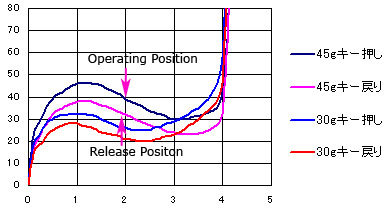The overall feel of a given switch depends on characteristics other than the actuation force.
For example, look at the force-displacement curves for a Cherry mx brown and Topre switches, including 45g:

Cherry mx Brown 45 cN ("grams") actuation force

Topre 30 and 45 cN ("grams") actuation force
In a Cherry mx brown switch, there is a stem that pushes down on a helical spring. The stem has a bump that requires additional force to overcome -- this is the "tactile bump" shown as the "pressure point" on the graph. Without the bump in the stem, you would have a perfectly linear force-displacement curve, such as found in the mx red switch. The "operating point" is the point at which the switch actuates. This occurs at a displacement of about 2 mm, which is half of the total travel of 4 mm from the starting point until bottoming out. You do not feel the actuation in a Cherry mx switch, but it does occur at about mid-travel, and it occurs at about 45 cN ("grams") -- this is the actuation force. Notice that beyond the actuation point, the force increases linearly until reaching a maximum of about 60 cN (or "grams"). When you release the switch, the force decreases past the "reset point" and there is another tactile bump as you move past the bump in the stem.
Now look at the Topre curve and focus on the top actuation curve, which is for the 45g Topre. In this case, the force increases to a maximum of about 45g as the rubber dome is compressed like a spring. But past this peak, the rubber dome collapses (unlike the spring in a Cherry mx switch, which does not collapse but just continues to be compressed). The dome is collapsing as you go past the actuation point ("operating position") of about 40 cN ("grams"). Again, in contrast to the Cherry mx switch, the force is
decreasing rather than increasing as you pass the actuation point. The force increases again upon bottoming out the switch.
Thus, comparing Cherry mx and Topre switches is rather like comparing apples to potatoes. Because of the differences in their force-displacement curves, the switches will feel very different, despite the fact that the actuation force can be the same -- in these cases, about 45 cN (grams).
To me, a Cherry mx brown feels a bit gritty because of the tactile bump grafted onto the switch stem, and it feels a bit heavier than a 45g Topre, because the force continues to increase after the actuation point. With the 45g Topre, the collapse of the dome provides a sense of release, something like the sensation of pressing a weighted piano key. Overall, I find the key action of a Torpe switch smoother and more satisfying that any Cherry mx switch.